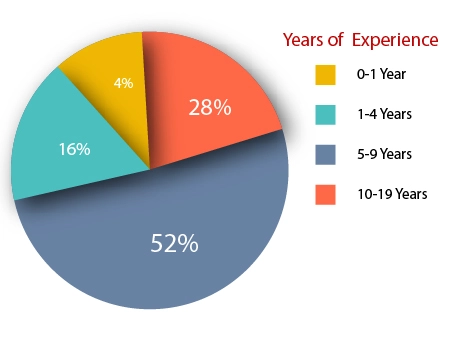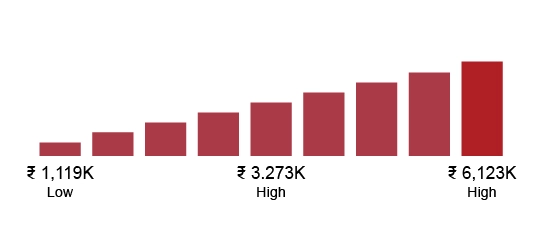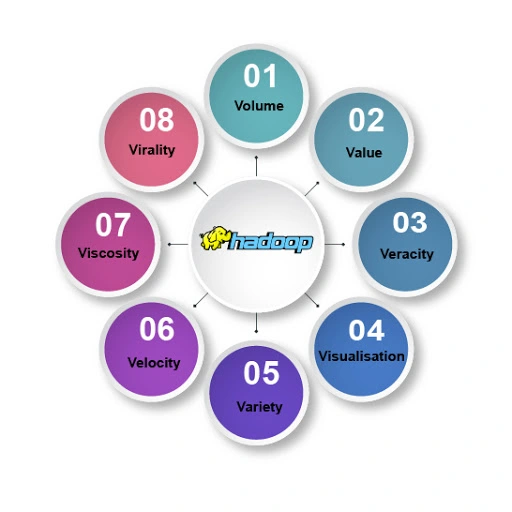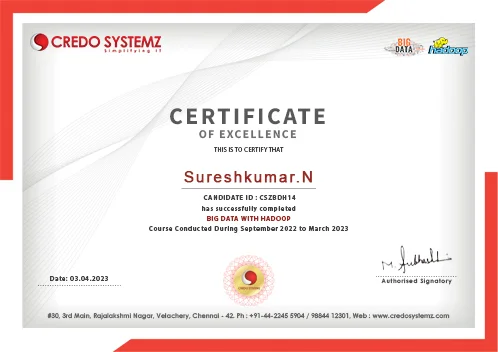Why Choose a course from Credo?
Our Big Data training in Chennai at Credo Systemz transforms our aspirants into Big Data experts with a successful career path. To expertise in Big Data, Enroll Now in Credo Systemz Big Data Training in Chennai.This Big Data Course in Chennai assists in acquiring the industrial skills of Big Data.
Find out what our past customers have to say about credo and their experiences with us
Flexible Mode of Training and Payment
Hear it from our customer!!
Our Big data Training Overview
Our Big Data course content covers all the essential Big Data concepts from basic to advanced level. It is prepared by our industrial trainers which is suitable for all aspirants. This Big Data Course content is standardized and reviewed frequently.
Big Data training in Chennai at Credo Systemz assists to enhance the knowledge of Big Data with its skills. Each Big Data concept is explained using full hands-on practice to face the real-time challenges.
Big Data Hadoop Training in Chennai at Credo Systemz which is handled by experienced professional. Our Big Data certification in chennai is focused on enhancing the skills of an individually in handling the data sets by real time case studies. Most importantly, joining this Big data courses in Chennai to here you can learn the top trending platforms like Hadoop ,Big Data Analytics and Spark Training. By our Hadoop training in Chennai with placement, you will attain 100% placement assistance from our placement team which incorporates the personal skill development, resume building, and updating about the current ongoing Hadoop job opportunities in India.
Credo Systemz offering Hadoop certification in chennai program as classroom, online and corporate training, you can book a free demo session with our Big Data Experts to choose your own Hadoop certification program.
Big Data Hadoop market report shares there will be significant growth in the year of 2020. The global market share of Hadoop has been increased all over the world including Asia, America, Europe, the Middle East, this results in more number of company growth and increase in the need for Hadoop Developers.

As an individual having Hadoop knowledge is very much required, Hadoop has also been listed as one of the important skillsets to have in 2020 according to Forbes 2020. Graphical representation of Hadoop Job opportunities given below,
There are various job roles are available in Big Data domain, these are
- Business Analyst
- Big Data Engineer
- Data Analyst
- Hadoop Developer
- Hadoop Admin
- Database developer
- Hadoop Tester
- Machine Learning Engineer
- Data Science

Here are the Top Best Big Data Certifications in 2020, Just take a glance.
- Data Mining and Applications Graduate Certificate
- MCSE: Business Intelligence
- SAS Certifications
- Hortonworks
- Oracle Business Intelligence (OBI)
- IBM Certified Solution Advisor: Big Data & Analytics V1
- HP Vertica Big Data Accredited Solutions Expert (ASE)
- Certified Analytics Professional (CAP)
- EMC Data Scientist Associate (EMCDSA)
- Cloudera Certified Professional Data Engineer
- Cloudera Certified Professional: Data Scientist (CCP: DS)
- Cloudera Certified Administrator for Apache Hadoop (CCAH)
- Data Science Council of America (DASCA)
Big Data Training Chennai – Our training program is designed to help the students who have successfully completed our training in Chennai and also give further experience in real time projects. We Provides 100% Placement assistance with following guidance,
- Frequent latest job updates.
- Resume building.
- Mock Interviews
- Interview questions.
- Certification guidance.
Big Data Corporate Training – Our Corporate training program will help your organization to train your employees in this field to an expert level. Our Real-time industrial experts will make sure to fulfill all your expectations.
Our Big Data Hadoop Certification is one of the recognized certifications which we provide to the candidate who successfully completes the project, mock interview, and assessment at the end of the session. As an individual, this certification will help you to showcase yourself as a professional in this technology and it will enhance your skillset as well. According our 2019 report, nearly 12500+ candidates have completed their Hadoop certification in our institute and working in top ITs in and around India.
- Credo Systemz is ranked as the Best Hadoop training institute in Chennai with placement for both Velachery and OMR, according to the more number of positive reviews across the internet.
- We are offering hadoop training in chennai velachery and hadoop training in chennai omr on both Weekdays and Weekends at flexible timing.
- Most Importantly Big Data course in Chennai velachery and OMR is handled by hadoop Professional Level Certified Trainers.
- In addition, we are providing the Online and Corporate Hadoop Training on tailor-made fees structure.
- For the most part, Our Hadoop Course Syllabus suits for both Beginners and Experienced Professional to enhance their skills.
- Our Hadoop Instructor has more than 12+ years of Industry experience. As a result, you can get updated and learn latest hadoop Topics.
- During the Big Data Hadoop course in chennai, you will get fully hands-on experience in real-time projects which boost the confidence level in aspirants to face the real-time challenges successfully.
- We will conduct hadoop Assessments and Mock Interview, so that we can evaluate candidate’s performance individually.
- Also, we will guide you to complete Big Data certification in chennai which will help you to stand out in the market.
- In addition, our Big Data Online course you can also attend our free Big Data workshops and discuss with our consultant to know about the topics, case studies and real-time Hadoop projects that is included in this training program.
- Consequently you will receive Job alerts to your registered email and whatsapp from our placement team and also we are doing Big Data hadoop training and placement in various ways.
Contact Us
+91-98844 12301 / +91-96001 12302
Training Benefits!!
Our Big Data training in Chennai is an exclusive advanced course to enhance the knowledge to become an expert in this methodology. The Professional trainers assist in upskilling Big Data with high industrial standards. Join us to become a pro in Big Data using our Big Data Course in Chennai.
-
5-15%
5-15% Chances of immediate placements.
-
10-15%
10-15% increase in salary.
-
~30%
30% of job market is open.
Testimonials
-
I joined Credo Systemz Big Data training by attending a demo class. Each Big Data Session covers essential skills with practical training which is the best. The Trainer is very supportive and always ready to guide. Thanks to my trainer.
Vinoth

-
Credo Systemz Big Data training is the instructor-led training course by professionals. This Big Data Course offers hands-on practices to learn Big Data effectively. I recommend this Big Data Course to gain the industrial experiences and skills development. Thanks to Credo Systemz.
Rajesh

Join Us
CREDO SYSTEMZ provides the Best Big Data Training in Chennai to promote you into a skilled professional with 100% Free Placement Support.
Join NowBig Data Course FAQs
Big Data is a term used to describe a massive volume of both structured and unstructured data so that is difficult to process in traditional database and software approach. It challenges include data analysis, search, capture, sharing, transfer, storage, visualization, and information privacy. It can be analyzed for insights and that leads to making better decisions and strategies for an organization.Our Big Data Certification course helps you to learn the tools practically and get certified, in order to build a successful career path.

“The best things in life are not planned, they simply just happen”
The above quote exactly suits for AngulrJS. Here is an interesting story behind the foundation of AngularJS.
In 2008, Misko Hevery a Google employee started to do a project about simplifying the web Application. The Project’s Aim is “Anyone can create web application easily, without prior knowledge of HTML and extending some existing HTML elements”. At the end of the project, he had a hard time explaining the project.
At that time, Misko’s manager asked him to work on one of the Google internal applications called Google Feedback Application. Along with Misko, another 2 developers started to write code but the code becomes 17000 lines. It was very hard to handle the code. In that application, to add one label in HTML you have to write plenty of code in Java and compile it.
Now Misko challenged his manager that he can develop this project with minimal code by using his Application (AngularJS) in 2 weeks. But he failed to do it in 2 weeks but did it in 3 weeks. The 17000 lines code reduced to 1500 lines in just 3 weeks. His Manager is very impressed and asked Misko to develop further the Angular framework.
Now Google’s internal Application is developed by Angular. The 1st version “AngularJs” or Angular 1.x released in 2010. Now the latest version is Angular 14 with updated techniques.
The overall, importance of Big Data is continuously increased in day by day. This year, early in January Big Data survey report saying almost 80% of an organization implementing and expanding the Big Data for their projects.
Following are the few new trends on Big Data @ 2020:
Internet of Things – In Internet of Things (IoT) deployments, Big data doing a great job to handle with a large amount of data.
DataOps: DataOps is defined as the concept of Agile and DevOps. It has been used in Big data life cycle to achieve the target.
Machine Learning and Artificial Intelligence – Machine learning is an important part of artificial intelligence. Machine Learning is used to analyze the data and create new ideas without being explicitly.
Hybrid Clouds – Hybrid Clouds offering the storage of data with private and public advantages. Data has been stored in secure with its own storage.
Big Data Certification Training will help you to become a Big Data expert. It will enhance your skills by providing you complete knowledge on Big data and have a need for hands-on experience for solving real-time industry-based Big Data projects. In Big Data and Hadoop course, you will be trained by our expert of following skills given below,
- Deep Understanding of Hadoop Distributed File System(HDFS), YARN and Map Reduce Concepts
- How to work with Hadoop resource and storage management
- Learn the data loading approaches using Sqoop and Flume
- Understand the Hive and Pig Differences
- Perform data analytics and ETL Operations using Pig and Hive
- Master in HBase Architectures and Mechanisms
- Work on real-time Mail Notification in Oozie
- Implementing Bucketing, Partitioning and Indexing in Hive
- Learn the Apache Spark and its Ecosystems
- How to create and work with RDD in Apache Spark
- Work on real-time Big Data Analytics projects
Big data applications are used in multiple domains in multiple applications. These are,
- Education
- Banking
- Healthcare
- Government Sector
- Manufacturing
- Media
- Cybersecurity
- Transportation
You can contact us via +91 9884412301 / 9600112302 or reach us via the contact form to book your seat in the upcoming batch for your Hadoop Big data training.
Sure you can book your free demo session and career counseling with our trainer and placement coordinators. To book please feel free to contact us via +91 9884412301 / 9600112302.
In order to meet the need of every individual, we used to offer different batch schedules like the classroom, online, corporate training and fast track sessions. You can book your batch according to your needs.
Yes, of course, Our Hadoop training will be handled by experts in the industry who have more than 15+ years of IT experience, This course will be handled with live practicals and real-time project scenarios to give you the live working environment as a Hadoop Developer. And we at Credo Systemz handling the Hadoop training program for the past 6+ years via classroom, online and corporate training programs.
Yes, we are providing 100% placement assistance. Credo Systemz helps the students with Professional resume building, various mock interviews, and group discussions training sessions for them to face the interview with confidence. So after the mock interview, we strive hard to improve your technical skill and interview confidence level. It acts as your promotion system until you get your dream job.
Feel free to contact us at any time via +91 9884412301 / 9600112302 to discuss further details even you can use our contact us form to share your details with us. .
To know about our exciting offers, concessions and group discount. Call us now: + 91 9884412301 / + 91 9600112302.
Feel free to enquire more. Mail us info@credosystemz.com or Call us now: + 91 9884412301 / + 91 9600112302.
Our Alumni Work in top MNC’S
Credo Systemz has placed thousands of students in various top multinational organiation, witnessing the progress of our alumni gives us immense gratification.
Join the success community to build your future
Enroll nowGet Industry Recognized Certification
Credo Systemz’s certificate is highly recognized by 1000+ Global companies around the world. Our Big Data certification showcases the in-built knowledge and professional skills of Big Data.
Benefits of Angular Certification
- To demonstrate the Proficiency of Big Data with its skills.
- To add weightage to your Professional resume and to stand out.
- To enhance your credibility in using Big Data effectively.













